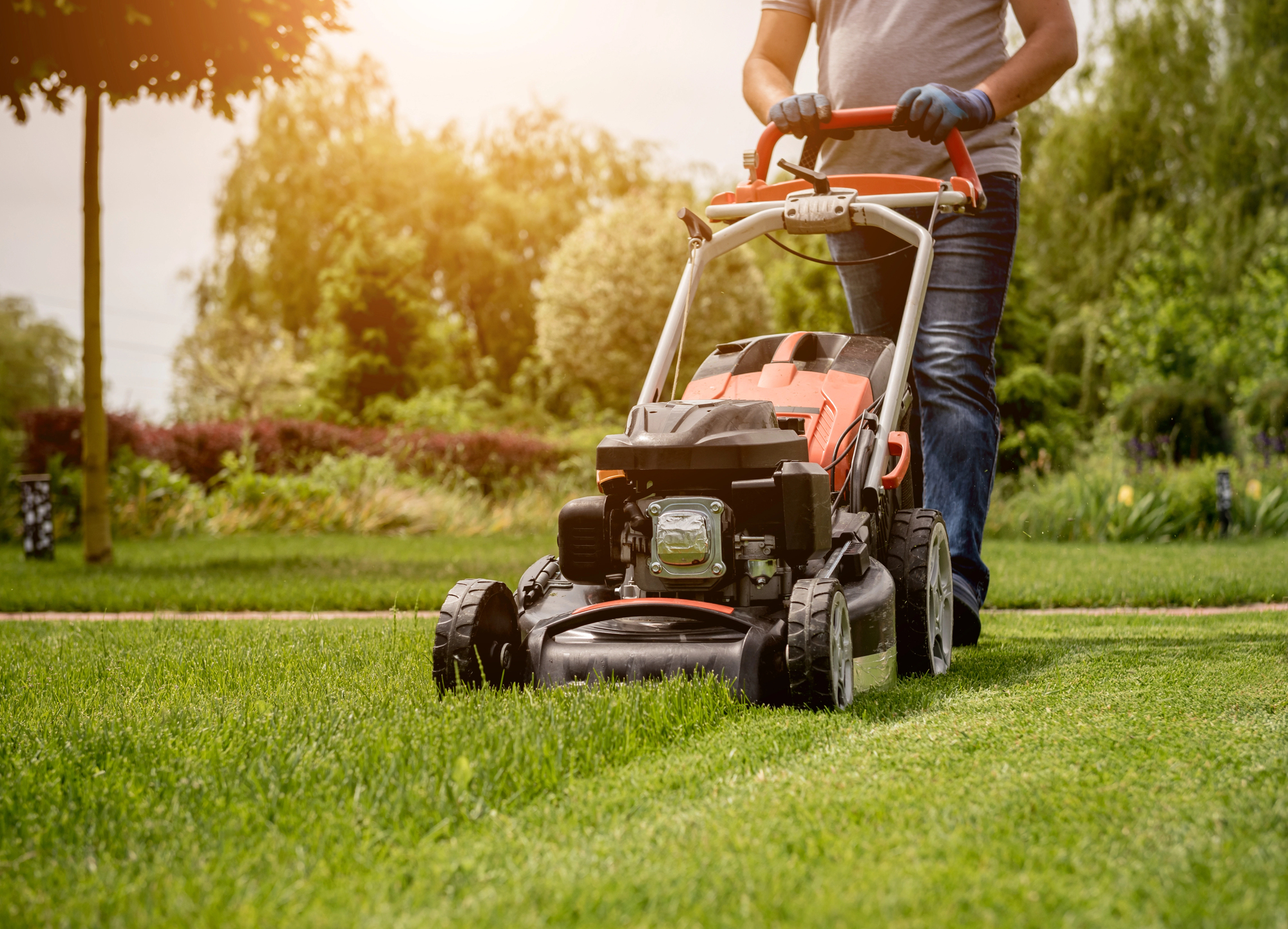Spring is finally here, and it’s the perfect time to get your lawn looking its best without spending every weekend on maintenance. As the days grow longer and temperatures rise, your lawn is waking up from winter dormancy and needs proper care to thrive throughout the growing season. The best low-maintenance lawn care strategies focus on working smarter rather than harder, establishing healthy grass that naturally resists weeds, pests and drought.
Many homeowners make the mistake of over-complicating their lawn care routines, leading to wasted time and resources. By understanding the basic needs of your grass type and local growing conditions, you can develop a simplified approach that delivers excellent results. A healthy lawn doesn’t require constant attention—it simply needs the right care at the right time.
Key Takeaways
- Simple spring tasks like proper mowing height, targeted watering and selective fertilising create lawns that need less maintenance year-round
- Addressing specific lawn problems early in spring prevents more labour-intensive fixes later in the growing season
- Different grass varieties have unique care requirements, so tailoring your approach to your specific lawn type maximises results with minimal effort
Evaluating Lawn Condition
Before starting spring lawn care, take time to assess your lawn’s health to identify specific issues that need attention.
Identifying Common Problems
The first step in spring lawn care involves checking for signs of winter damage. Walk around your garden and look for bare patches where grass has died or thinned out. These areas will need reseeding once soil temperatures reach about 10°C.
Next, examine your lawn for lawn weeds like dandelions, clover, and plantain. Early spring is an ideal time to tackle these invaders before they become established. Hand-pulling is effective for small numbers, while spot treatments work better for larger infestations.
Check for moss in shaded or poorly drained areas. If found, consider using a moss killer followed by raking out the dead material. Moss typically indicates underlying issues such as compacted soil, poor drainage, or too much shade.
Test soil compaction by pushing a garden fork into the lawn. If it’s difficult to insert, your lawn likely needs aeration to improve root growth and water penetration.
Lastly, assess the soil pH using a simple test kit. Most grasses prefer a slightly acidic to neutral pH (6.0-7.0). Adjustments can be made with lime to raise pH or sulphur to lower it.
Essential Lawn Maintenance Techniques
Proper lawn care requires several key techniques that promote healthy grass growth while reducing the need for constant attention. These fundamental practices help establish a resilient lawn that can withstand seasonal challenges.
Aeration and Scarifying
Aeration involves creating small holes in the soil to allow air, water and nutrients to penetrate the grass roots. This technique is particularly beneficial for lawns with compacted soil. Using a garden fork for small areas or hiring a mechanical aerator for larger lawns will yield the best results.
Spring is an ideal time for this task as the soil warms and grass begins active growth. The holes should be approximately 7-10 cm deep and spaced about 10-15 cm apart for maximum effectiveness.
Scarifying removes thatch—the layer of dead grass that builds up between the soil and green growth. Use a lawn rake or scarifier to remove this debris, which can prevent water and nutrients from reaching the roots.
For best results, scarify when the lawn is actively growing in mid-spring. Start gently and increase pressure as needed. This process may temporarily make your lawn look worse but will promote healthier growth within weeks.
Mowing Practices
Regular mowing is essential for maintaining a healthy lawn. Begin the mowing season when grass reaches about 5-7 cm in height, typically in early spring.
Set your mower blade height correctly—never remove more than one-third of the grass height in a single cut. For spring, maintain a cutting height of about 2.5-4 cm for most grass types.
Keep mower blades sharp to ensure clean cuts. Dull blades tear rather than cut grass, leading to brown tips and potential disease entry points.
Consider creating a defined mowing strip around flower beds and paths. This creates a clean edge and prevents grass from encroaching into garden areas.
Change your mowing pattern regularly to prevent soil compaction and encourage upright growth. Alternate between diagonal, horizontal and vertical cutting patterns for best results.
Weeding and Moss Control
Tackle weeds early in spring before they establish deep root systems. Hand pull isolated weeds, ensuring you remove the entire root to prevent regrowth.
For larger infestations, consider spot treatments rather than blanket applications of herbicides. Apply on calm, dry days when rain isn’t forecast for at least 24 hours.
Moss thrives in damp, shady areas with poor drainage and acidic soil. Improve drainage by aerating compacted areas and consider pruning overhanging branches to increase sunlight.
Apply a moss control product in early spring following package instructions carefully. After treatment, rake out dead moss thoroughly.
Adjust soil pH if moss is persistent—most lawn grasses prefer slightly acidic to neutral soil (pH 6.0-7.0). A soil test can determine if lime application is needed to raise pH levels.
Lawn Feeding and Fertilisation
Proper feeding and fertilisation are essential components of spring lawn care that promote healthy growth and vibrant colour. Nutrients applied at the right time and in correct amounts will strengthen your lawn against weeds and disease.
Understanding Fertilisers
Lawn fertilisers contain three main nutrients: nitrogen (N), phosphorus (P), and potassium (K). These are typically represented by three numbers on fertiliser packaging, such as 20-5-10. Nitrogen promotes leaf and stem growth, creating that lush green appearance. Phosphorus supports root development, which is particularly important after winter dormancy. Potassium helps with disease resistance and overall plant health.
Slow-release fertilisers are ideal for spring applications as they provide nutrients gradually over 6-8 weeks. This reduces the risk of burning the grass and minimises nutrient runoff. Organic options like compost tea or well-rotted manure offer natural alternatives that improve soil structure alongside nutrient delivery.
A soil test can reveal existing nutrient levels and pH, helping you select the most suitable products for your lawn’s specific needs.
Applying the Right Nutrients
The timing of fertiliser application is critical for maximum benefit. Wait until your lawn shows active growth in spring, typically when soil temperatures reach about 10°C. Early to mid-April is often suitable for most UK lawns.
When applying lawn feed, follow these steps for best results:
- Mow the lawn 2-3 days before application
- Choose a dry, calm day with rain forecasted within 24-48 hours
- Use a spreader for even distribution
- Apply at the recommended rate (over-feeding can damage grass)
The application rate typically ranges from 25-35g per square metre, but always check the product guidelines. For centipede or other acid-loving grasses, select a fertiliser with lower phosphorus content.
Remember to water the lawn thoroughly after applying if no rain is expected. This helps dissolve the fertiliser and move nutrients into the soil where roots can access them. Avoid fertilising during drought conditions or when grass is wet from dew or rain to prevent leaf burn.
Weed Control Strategies
Keeping your lawn weed-free requires both preventive approaches and targeted treatments when weeds appear. Effective management combines cultural practices that discourage weed growth with selective herbicide use when necessary.
Preventive Measures
Proper lawn maintenance forms the foundation of weed prevention. Mowing at the correct height (typically 6-8 cm for most grass varieties) helps shade the soil and prevents weed seeds from germinating. Regular watering that promotes deep root growth rather than frequent shallow watering gives your grass a competitive advantage over weeds.
A thick, healthy lawn naturally crowds out unwanted plants. Overseeding thin areas in early spring fills bare patches before weeds can establish themselves. Choose grass seed appropriate for your specific conditions and climate zone for best results.
Adding a 5-10 mm layer of compost to your lawn each spring can improve soil structure and provide nutrients that favour grass over weeds. Aerating compacted soil also encourages deeper grass root growth, helping your lawn outcompete common lawn weeds.
Herbicidal Solutions
When weeds appear despite preventive efforts, herbicides may be necessary. Pre-emergent herbicides create a barrier that prevents weed seeds from developing. Apply these in early spring before soil temperatures reach 10°C, which is when many annual weeds begin to germinate.
Selective post-emergent herbicides target specific weed types while leaving grass unharmed. Products containing ingredients like MCPA or dicamba effectively control broadleaf weeds such as dandelions and clover. Always read labels carefully and apply according to the manufacturer’s instructions.
Spot treatment is often more effective and environmentally responsible than blanket applications. Use ready-to-use sprays for isolated weeds or apply concentrated solutions with a brush directly to weed leaves for persistent perennials like ground elder or bindweed.
Non-chemical alternatives include boiling water or vinegar solutions for weeds in paths or driveways, but be aware these will harm any plant they contact. A flame weeder works well for weeds in gravel areas, but should never be used on dry lawns.
Seeding and Overseeding
Spring provides an ideal time to address thin patches in your lawn through seeding or overseeding. These processes help fill in bare spots and improve overall lawn density without requiring constant attention.
Choosing the Right Grass Seed
The success of seeding begins with selecting appropriate grass seed for your climate and lawn conditions. Cool-season grasses like Kentucky bluegrass, perennial ryegrass, and tall fescue work best when planted in early spring in cooler regions. Warm-season varieties such as Bermuda and Zoysia thrive when planted in late spring as temperatures rise.
Check the seed label for:
- Germination rate (should be above 85%)
- Purity percentage (aim for 95% or higher)
- Weed seed content (lower is better)
Consider your lawn’s sun exposure before purchasing. Shaded areas require specific shade-tolerant seed mixes, while sunny patches need drought-resistant varieties. Many quality lawn seed packages indicate their sunlight requirements.
A seed mixture often provides better results than a single variety, offering improved disease resistance and adaptability to varied conditions.
Repairing Bare Spots
Bare spots in lawns can result from foot traffic, pet damage, disease or poor growing conditions. Begin repairs by removing dead grass and loosening the top 2-5 cm of soil with a garden rake. This creates the proper seed-to-soil contact essential for germination.
For small areas, mix:
- 3 parts topsoil
- 1 part compost
- Appropriate amount of grass seed
Spread this mixture evenly over the bare spot, ensuring it sits level with the surrounding lawn. Water lightly twice daily until seedlings reach 3 cm tall. Avoid heavy watering that might wash away seeds.
Apply a thin layer of straw mulch to retain moisture and protect seeds from birds. For larger areas, consider using a seed spreader set at half the recommended rate, making two passes in perpendicular directions for even coverage.
Most lawn seed germinates within 7-21 days depending on variety and temperature. Keep foot traffic away from newly seeded areas for at least three weeks.
Lawn Edging for a Polished Look
Clean, well-defined edges give your lawn a neat, professional appearance and create clear boundaries between grass and garden beds or pathways. They help prevent grass from invading flower beds and make mowing easier.
Creating and Maintaining Edges
A sharp spade or half-moon edger is the most basic tool for creating lawn edges. Insert the blade straight down about 7-10cm deep along the desired line and remove excess soil and grass. For established edges, an edging shear helps trim overgrown grass without damaging the edge structure.
Consider installing permanent edging materials like metal strips, plastic, brick or stone for a longer-lasting solution. These barriers require less maintenance and provide year-round definition.
When mowing, use the highest appropriate setting for your grass type. Cutting grass too short weakens it and allows weeds to establish. Taller grass develops deeper roots and withstands drought better.
For compacted soil along edges, use a garden fork to aerate these areas. Push the fork about 10-15cm into the soil and gently rock it back and forth. This improves drainage and encourages healthy root growth.
Trim edges every 2-3 weeks during the growing season. For curved edges, use string or a garden hose to mark out flowing lines before cutting.
Caring for Different Types of Grass
Different grass types require specific care routines based on their growth habits and climate adaptations. Understanding your lawn’s specific grass type helps you provide the right maintenance at the right time for optimal health.
Warm Season Grasses
Warm season grasses thrive in temperatures between 24-35°C and grow actively during late spring and summer. Bermuda grass requires full sun exposure and can be mowed quite short (1.5-2.5 cm) for a manicured look. This grass type needs regular fertilisation during its growing season but becomes dormant and browns in cooler months.
Centipede grass offers excellent low-maintenance options for sandy, acidic soils. It needs less fertiliser than other varieties and should be cut at 4-5 cm height. Avoid over-fertilising centipede grass as this can lead to excessive thatch build-up.
Zoysia grass forms a dense, carpet-like lawn that resists weeds effectively. It should be mowed at 2.5-5 cm and requires less frequent watering once established. Zoysia’s slow growth rate means less mowing but also slower recovery from damage.
For all warm-season grasses:
- Water deeply (2.5 cm) once or twice weekly
- Fertilise primarily during active growth periods
- Reduce irrigation in autumn as dormancy approaches
Cool Season Grasses
Cool season grasses perform best in temperatures between 15-24°C, with peak growth in spring and autumn. Kentucky bluegrass creates a lush, carpet-like lawn but demands more water and fertiliser. Mow at 6-7.5 cm height during hot periods to reduce stress.
Perennial ryegrass establishes quickly from seed and offers good wear resistance. It performs well in partially shaded areas and should be cut at 5-6 cm height. Fine fescue varieties include creeping red, chewings and hard fescue, all requiring minimal maintenance.
Fine fescue tolerates shade and drought better than other cool-season grasses. It grows well in poor soils with minimal fertiliser and should be mowed at 7.5-10 cm. This grass type rarely needs irrigation once established except during extended dry periods.
Spring care for cool-season grasses:
- Apply fertiliser in early spring (lower nitrogen content)
- Mow regularly once growth begins
- Address bare patches with overseeding
- Water deeply but infrequently to encourage deep root growth
Many UK lawns contain a mixture of cool-season grasses to provide resilience against varying conditions throughout the year.





